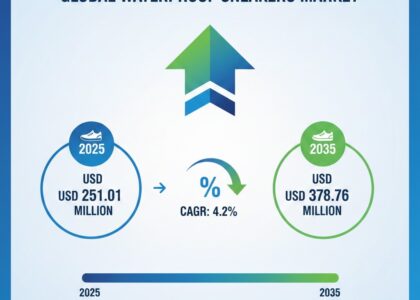Between 2025 and 2035, the home security sensors market will see immense growth driven by widespread use of intelligent security solutions and continuing advances in domestic monitoring technology. The industry will grow from USD 21.21 billion in 2025 to USD 47.05 billion in 2035; and, during this forecast period, it is expected to maintain a CAGR of 8.3%.
The home security sensors market has seen significant advancements in recent years, driven by the rising concern for safety and the increasing adoption of smart home technologies. These sensors, which include motion detectors, door/window sensors, glass break detectors, and others, play a crucial role in safeguarding residential properties against unauthorized access, theft, and other potential threats. With growing urbanization and increasing disposable incomes, consumers are becoming more inclined to invest in reliable home security solutions, pushing the demand for innovative and efficient sensor technologies.
Technological advancements such as AI integration, wireless communication, and the Internet of Things (IoT) have transformed traditional home security systems into intelligent, automated setups. This transformation has expanded the reach of the home security sensors market beyond just physical protection, including monitoring for environmental hazards like smoke, gas leaks, and water intrusion. As a result, the market is poised to witness continued growth, fueled by rising consumer awareness and the proliferation of smart devices in residential spaces.
Get Sample Report: – https://www.futuremarketinsights.com/reports/sample/rep-gb-1918
Market Trends
The home security sensors market is currently shaped by several notable trends that are redefining how consumers approach residential safety. One of the most significant developments is the increasing integration of home security sensors with smart home ecosystems. Products now offer seamless compatibility with digital assistants like Amazon Alexa, Google Assistant, and Apple HomeKit, allowing users to control and monitor their security systems using voice commands or mobile apps.
Another emerging trend is the shift toward wireless and battery-powered sensors. These offer easier installation and flexibility in placement, removing the need for extensive wiring or professional help. Additionally, manufacturers are focusing on miniaturization and aesthetic design to ensure that sensors blend effortlessly into modern home interiors without compromising functionality.
The rise of do-it-yourself (DIY) security systems has also contributed to market evolution. Consumers are now more comfortable installing their own home security sensors, particularly as user-friendly kits become more available through e-commerce channels. Cloud-based monitoring and real-time mobile alerts are also gaining traction, giving homeowners remote control and peace of mind.
Driving Forces Behind Market Growth
Several factors are driving the expansion of the home security sensors market. A primary driver is the growing concern over residential crime rates, which has made security a top priority for homeowners. This concern is amplified by media reports and public safety campaigns, which consistently stress the importance of preventive measures.
Another key factor is the surge in smart home adoption. As more consumers invest in connected devices, there is a natural extension toward integrating smart security solutions. Home security sensors are now being designed to work in harmony with a range of home automation technologies, from smart lights to door locks, enhancing their appeal.
Government initiatives and insurance incentives are also playing a role. In many regions, installing certified security systems can lead to reduced home insurance premiums, encouraging more homeowners to adopt advanced sensors. Additionally, rising disposable incomes and increased awareness of technological advancements have broadened the market’s reach across different demographics and regions.
Challenges and Opportunities
Despite its strong growth trajectory, the home security sensors market faces several challenges. One of the key hurdles is the high initial investment required for comprehensive security setups. While DIY options have lowered entry costs, advanced features such as facial recognition or AI-based threat detection still come at a premium, limiting access for budget-conscious consumers.
Data privacy concerns also pose a challenge. As home security systems become more interconnected and reliant on cloud storage, consumers are becoming increasingly wary of how their data is collected and used. Addressing these concerns will be vital for sustaining long-term market growth.
However, these challenges also present opportunities. Companies that can offer affordable, scalable, and secure solutions stand to gain a competitive edge. Emerging markets present another avenue for growth. As digital infrastructure improves in developing countries, there is significant potential for market penetration. Additionally, advancements in sensor technology, such as improved accuracy, lower power consumption, and enhanced connectivity, are likely to unlock new applications and revenue streams.
Recent Industry Developments
- Recent innovations in the home security sensors market reflect the industry’s dynamic nature. Manufacturers are increasingly investing in research and development to create more intelligent, adaptive sensors capable of distinguishing between different types of movement or environmental changes. For example, AI-enabled sensors can now differentiate between a pet and a human intruder, reducing false alarms.
- Partnerships and collaborations are also shaping the industry landscape. Tech giants are teaming up with security companies to integrate their ecosystems, enhancing functionality and user experience. These strategic alliances are leading to more comprehensive and seamless security solutions for end users.
- Another notable development is the growing focus on sustainability. Energy-efficient sensors, recyclable components, and longer-lasting batteries are being prioritized in response to environmental concerns and consumer preferences. The use of edge computing is also on the rise, allowing data to be processed locally rather than in the cloud, thereby enhancing speed and reducing privacy risks.
Regional Analysis
The home security sensors market displays diverse growth patterns across different regions. North America currently dominates the market, thanks to high consumer awareness, advanced technological infrastructure, and widespread adoption of smart home solutions. The United States, in particular, accounts for a significant share, driven by strong demand for integrated security systems.
Europe follows closely, with countries like Germany, the UK, and France showing robust adoption. The European market benefits from strict regulatory standards and strong consumer advocacy for data protection, which has driven demand for secure and compliant home security products.
The Asia-Pacific region is emerging as a lucrative market, propelled by rapid urbanization, increasing disposable income, and rising concerns about home safety. Countries like China, India, and South Korea are witnessing growing interest in home automation and smart security, supported by improving internet penetration and growing smartphone usage.
Latin America and the Middle East & Africa are also showing signs of steady growth, although infrastructure limitations and economic disparities may temporarily restrain full-scale adoption. Nevertheless, the overall global outlook remains positive, with all regions contributing to the expanding reach of the home security sensors market.
Competitive Outlook
Competition in the home security sensors market is intensifying, as both established players and new entrants vie for market share. Established companies benefit from brand recognition, extensive distribution networks, and comprehensive product portfolios. However, startups and tech companies are bringing fresh innovation and disruptive pricing strategies that appeal to a new generation of consumers.
The market is characterized by continuous innovation, with companies striving to offer differentiated features such as AI integration, facial recognition, real-time mobile alerts, and cloud storage. Customer support, user interface design, and seamless integration with other smart home devices have become crucial differentiators in the competitive landscape.
Mergers, acquisitions, and strategic alliances are also influencing competition. Companies are acquiring niche players to expand their technological capabilities and reach. At the same time, investment in marketing and consumer education is becoming increasingly important to build trust and drive adoption.
Top Companies
The home security sensors market is populated by several major players who have established themselves through innovation, quality, and strategic partnerships. Companies like Honeywell International Inc., Bosch Security Systems, Johnson Controls, and ADT Inc. have long-standing reputations and offer a wide range of sensor-based solutions tailored for residential use.
Other key players include SimpliSafe, Ring (an Amazon company), and Arlo Technologies, which have gained popularity through their user-friendly, DIY-oriented offerings. These companies leverage strong digital platforms and customer engagement to build brand loyalty and expand their market footprint.
Emerging players and regional firms are also contributing to the competitive diversity. With the barrier to entry lowered by e-commerce and cloud technology, smaller firms are finding ways to innovate and attract niche segments. This vibrant competitive environment ensures that consumers have access to a variety of choices tailored to different budgets and needs.
Explore In-Depth Analysis-Click Here to Access the Report:- https://www.futuremarketinsights.com/reports/home-security-sensors-market
Segmentation Outlook
The home security sensors market can be segmented based on type, connectivity, application, and region. By type, the market includes motion sensors, door/window sensors, glass break detectors, and environmental sensors such as smoke and gas detectors. Among these, motion sensors are widely used due to their broad applicability and effectiveness in detecting unauthorized movements.
In terms of connectivity, the market is divided into wired and wireless segments. Wireless sensors are increasingly preferred for their ease of installation and flexibility, especially in retrofit applications.
Application-based segmentation reveals a focus on residential spaces, although some solutions are also applicable to small businesses or shared housing. Region-wise segmentation highlights varying levels of adoption and market maturity, with North America and Europe leading the way, followed by rapid growth in Asia-Pacific.
About Future Market Insights (FMI)
Future Market Insights, Inc. (ESOMAR certified, recipient of the Stevie Award, and a member of the Greater New York Chamber of Commerce) offers profound insights into the driving factors that are boosting demand in the market. FMI stands as the leading global provider of market intelligence, advisory services, consulting, and events for the Packaging, Food and Beverage, Consumer Technology, Healthcare, Industrial, and Chemicals markets. With a vast team of over 400 analysts worldwide, FMI provides global, regional, and local expertise on diverse domains and industry trends across more than 110 countries.
Contact Us:
Future Market Insights Inc.
Christiana Corporate, 200 Continental Drive,
Suite 401, Newark, Delaware – 19713, USA
T: +1-347-918-3531
For Sales Enquiries: sales@futuremarketinsights.com
Website: https://www.futuremarketinsights.com
LinkedIn| Twitter| Blogs | YouTube






